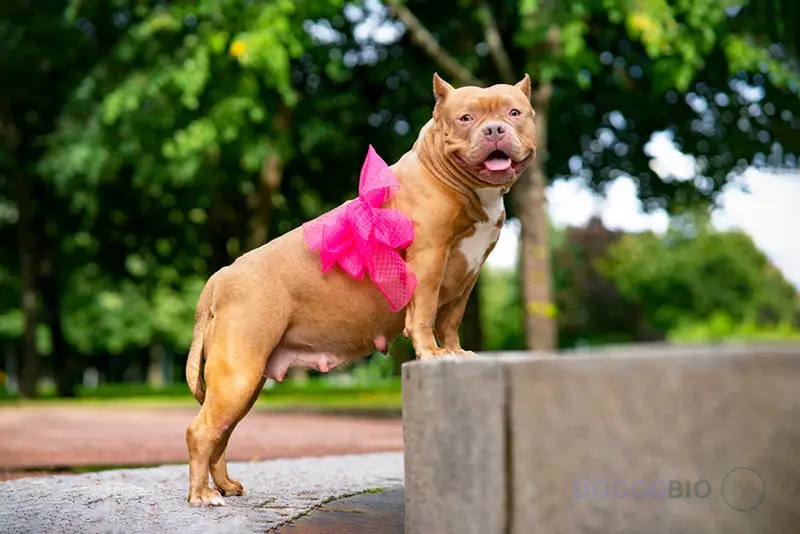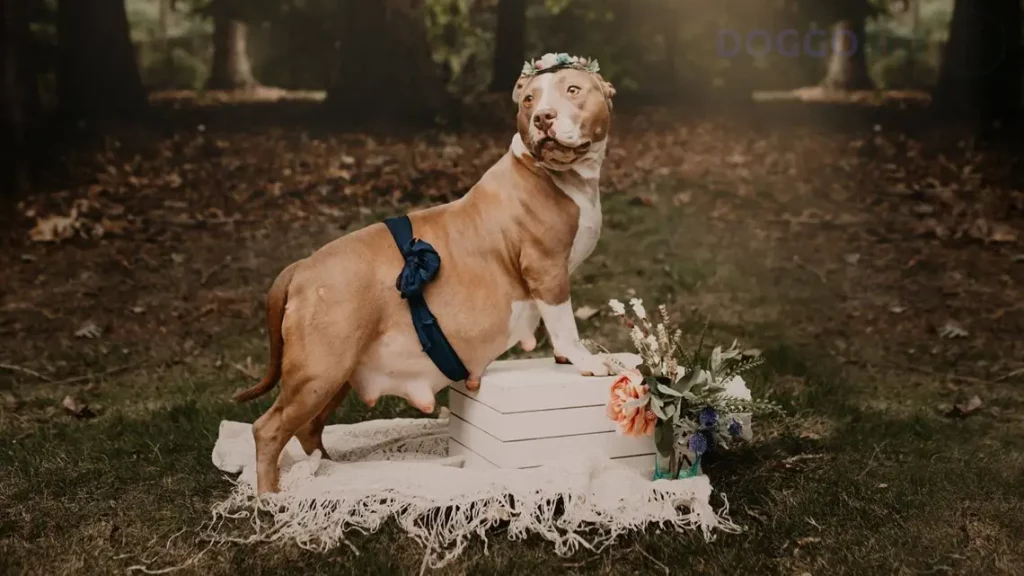Pitbulls are a famous and beloved breed of dog known for their athleticism, loyalty, and affectionate nature. If you are a Pitbull owner, you may be considering breeding your dog and wondering what to expect during the pregnancy.
In this article, we will explore the topic of Pitbull pregnancy, including the signs of pregnancy, care requirements for the pregnant dog, and what to expect during the delivery process.
By understanding more about Pitbull pregnancy, you can provide your dog with the care and attention she needs to have a safe and healthy pregnancy and ensure the health of puppies.
How Long Are Pitbulls Pregnant?
The length of Pitbull pregnancy is roughly around 62-64 days or about two months, but predicting delivery timing can be challenging as the date of breeding doesn’t always match conception. Breed and litter size can also impact pregnancy length.
During the initial month of pregnancy, fertilized eggs travel to the uterine horn and embed themselves in the lining, which takes about 15-18 days. It’s speedy during this time, with the swellings doubling in diameter every seven days.
At the first month’s end, a vet can detect a fetal heartbeat, and as the second month begins, embryos become recognizable puppies, and development accelerates. At the end of the second month, the puppies are fully formed and prepared to be born.
Signs of Pitbull Pregnancy

1. Behaviors and physical changes
One of the most noticeable signs of Pitbull pregnancy is a behavior change. If your Pitbull is ordinarily attention-seeking but has become more detached and reserved, or if they are usually timid but seeks more comfort, it is likely due to pregnancy.
Common behavioral signs of early Pitbull pregnancy include lethargy, shyness, and being less active than usual. Observing your Pitbull becoming quickly tired and napping more frequently is normal.
However, suppose your dog is typically full of energy, and the decline in power is sudden. In that case, it may not be pregnancy but other severe conditions that need to be evaluated by a vet.
As the pregnancy progresses, you will also likely witness a change in your affection for items such as toys, food, or even clothes as maternal instincts manifest.
2. Increased appetite
Feeding your Pitbull pregnancy be quite a challenge. You’ll see fluctuations in their appetite during the different pregnancy stages, perplexing you.
Early in pregnancy, your Pitbull may experience a loss of appetite, refusing even their favorite treats. They might also puke their guts out after eating, as if they’ve just emerged from an all-night rave party.
In the later stages of pregnancy, they’ll develop a voracious appetite and may turn their nose up at their former favorite foods. They might even growl at you if you dare to deny them seconds!
Don’t panic if your Pitbull pregnancy eating habits change. It’s perfectly normal. But if your pup refuses to eat for more than a few days, it’s time to take them to the vet for a checkup.
3. Increase in nipple size
Get ready to notice dramatic physical changes in your Pitbull’s nipples during pregnancy. Ordinarily small, flat, and light red, they will undergo dramatic transformations with the onset of pregnancy.
As early as the first stages of pregnancy, the nipples will begin to enlarge, and the areolas will become more round. This is a definite sign that the body is preparing for the arrival of little puppies.
But that’s not all! In addition to getting more significant, the nipples will also change color. The increased blood flow to the area will cause them to darken, and they may even leak milk by the later stages of pregnancy!
So, don’t be alarmed if you see your Pitbull’s nipples looking larger, rounder, and darker than usual during pregnancy. It’s a perfectly normal and natural part of the process.
4. Weight Gain & Swollen belly
Weight gain and an enlarged abdomen are two unmistakable signs of Pitbull pregnancy. The belly has to expand to accommodate the growing puppies, leading to a noticeable increase in weight.
If you observe your Pitbull’s weight increasing without a clear explanation, such as overfeeding, illness, or lack of exercise, she is likely pregnant.
The belly’s enlargement is a sign of advanced pregnancy, so you should visit a veterinarian as soon as you notice this sign if you have not already sought medical advice about your dog’s pregnancy.
How to tell if dog is pregnant?
Confirmation of Pitbull pregnancy is essential to prepare for the upcoming birth. Here are two methods to confirm if your Pitbull is pregnant:

1. Ultrasounds
Ultrasounds can be done as early as 25 days after mating to determine whether your Pitbull has conceived. However, if done earlier, the results may be partially accurate. While ultrasounds are non-invasive, the process can be stressful for your Pitbull as the hair on its belly will be shaved off, and it may not enjoy the visit to the vet. Ultrasound for pregnancy checks can range from $300 to $500, which can be costly for some owners.
2. Palpation
When determining if your Pitbull pregnancy, no easy at-home tests are available like those for humans. Fear not, as there are ways to confirm if your dog is expecting. The most reliable method to check for pregnancy is through diagnostic testing.
Abdominal palpation is one such method. This method involves a veterinarian checking your dog’s abdomen around 28-30 days after breeding. At this stage of pregnancy, the puppies feel like small golf balls or grapes, depending on the dog’s size. These balls are fluid-filled sacks surrounding the fetus. However, it is essential to note that abdominal palpation should not be attempted without the assistance of a veterinarian, as it could harm the pups. Additionally, the sacks lose their distinctive shape after one month, so the timing of this test is critical.
3. X-ray
X-raying a dog is an excellent method to determine if Pitbull is pregnant. However, waiting until day 55 or more is crucial, as the puppies’ skeletal structures aren’t visible until then. Waiting until this time will allow you to accurately count the number of puppies, giving you a better understanding of when your dog will finish delivering.
X-rays use electromagnetic radiation, so taking precautions is essential to avoid exposing the puppies to harmful radiation. The American Veterinary Medical Association advises against X-raying pregnant dogs during the first 25 days of gestation to minimize potential risks.
4. Blood Sample
This test detects the pregnancy hormones in your Pitbull’s blood. This option is more affordable than ultrasound and can be done five weeks after mating to ensure precise results.
However, be warned that the outcome may be incorrect if the test is done too early. For instance, if your Pitbull has been pregnant for less than 35 days, the results may return negative. It’s better to wait a little while and not rush things.
Pitbull Pregnancy Stages
The anticipation of a Pitbull pregnancy can be exhilarating, but what exactly are the Pitbull pregnancy stages? Let’s take a perplexing look at each location.

Month 1
In month one, things may seem unremarkable, and you may not even notice anything is different. Some owners may be unable to tell their Pitbull is pregnant without an ultrasound. On day 7 of the Pitbull pregnancy, puppy embryos will arrive at the uterine horns. By days 14 to 16, the Pitbull embryos will attach to the mother’s uterus lining. It’s typically around day 22 that the Pitbull fetuses will begin to form, and on day 29, veterinarians can detect heartbeats using an ultrasound scan.
Now that your Pitbull is three weeks pregnant, you may notice some of the signs I mentioned earlier. However, those signs may even change a bit, such as your Pitbull eating more than usual after experiencing a loss of appetite earlier in the pregnancy. Your Pitbull’s nipples should also be more significant than before, and she might start seeking more comfort and cuddles from her owner.
Additionally, your Pitbull may experience a clear discharge during the fourth week, begin to slow down and reduce her activity levels. She may even display signs of canine morning sickness. It’s important to remember that while these are typical signs of a Pitbull pregnancy, not all Pitbulls will exhibit them. It’s still very early in the pregnancy and can be difficult to detect accurately.
Month 2
As you delve into the second month of your Pitbull pregnancy, the excitement sets in. This phase is marked by an acceleration in pregnancy signs, with the fetuses’ eyelids and toes appearing between the 32nd and 35th day.
Development progresses remarkably, with Pitbull fetuses growing claws by day 40, forming a skeletal structure, and even sprouting a coat by day 45.
Around the 50th day, you can request an X-ray from your vet to determine how many puppies your Pitbull carries. This is an incredibly thrilling time, as it allows you to plan for the size of the litter!
As you approach the 58th day, your Pitbull will begin to exhibit nesting behavior. This entails looking for a safe and cozy spot in the house to give birth, and you can aid your furry friend by providing extra bedding and creating a more secure environment.
By now, it should be apparent that your Pitbull is pregnant, as her belly will be noticeably rounder. Other signs of Pitbull pregnancy in the second month include:
- Significant weight gain.
- The increased appetite (which may taper off around day 45).
- More frequent urination.
- A clear vaginal discharge.
- A firming of the belly between the 45th and 50th days.
Keep a close eye on your Pitbull’s belly, as by day 50. You might even see movement from the puppies!
Month 3
Welcome to the exciting third month of your Pitbull pregnancy! The anticipation is palpable at this stage as your furry friend is finally ready to give birth.
The first sign is that her waist will get slimmer as the puppies move into position. But don’t be fooled – this doesn’t mean she’ll be less hungry! She’ll still have a big appetite until around days 61 and 62, when she might not want to eat much.
Around one to two days before the birth, you’ll notice a drop in your Pitbull’s temperature. This is a sign that the puppies are on their way, so ensure everything is ready for arrival.
As the time draws near, your Pitbull will become more agitated and restless, exhibiting increased nesting actions like digging, pacing, panting, and shivering. This is entirely normal, and providing her with a safe and comfortable space to give birth is essential.
And then, the moment we’ve all been waiting for – the puppies will start to move into the birth canal for the last few days of pregnancy, almost fully formed and ready to enter the world.
Caring for a Pitbull Pregnancy

1. Proper Nutrition
Caring for a pregnant dog can be daunting, but ensuring her and her puppies’ health is essential. Proper nutrition is crucial during Pitbull pregnancy, as it can affect the growth and development of the puppies.
If your dog is already on good quality dog food and is at a healthy weight, you won’t have to change her diet for the first two-thirds of Pitbull pregnancy unless otherwise directed by your veterinarian. However, as her weight increases in the last weeks of pregnancy, veterinarians recommend gradually increasing her food intake.
It’s important to increase her food intake slowly and feed her small, frequent meals, as large meals can cause discomfort. Expanding the food at the wrong time can be harmful, so follow your vet’s recommendations.
2. Exercise and rest
Exercise is essential during pregnancy, but your dog should not engage in strenuous activity. A moderate amount of exercise, such as short walks, benefits both the mother and the puppies.
Rest is also essential for Pitbull pregnancy, especially in the last weeks of pregnancy. Provide a comfortable and quiet place for your dog to rest and avoid stressful situations.
3. Veterinary care
Your dog’s health during pregnancy is crucial, so visiting the vet regularly is essential. Before breeding, take your dog to the vet for a prenatal checkup and vaccinations. A fecal exam or deworming may also be recommended to ensure your dog is healthy.
During the third trimester of Pitbull pregnancy, deworming with Fenbendazole can help prevent roundworm and hookworm infections in newborn puppies.
Ask your vet about emergency plans and what to do during labor. They will also examine your dog for any potential complications that may prevent a normal birth and discuss options for cesarean delivery if necessary.
If your dog’s pregnancy is accidental, this is an excellent time to discuss spaying to prevent future litters.
Tips and tricks for Pitbull pregnancy
Prepare yourself for the arrival of your Pitbull puppies with these pregnancy tips.
You will see significant behavior and physical changes during your Pitbull pregnancy, which lasts from 58 to 68 days. You must be aware of these changes and adjust your care accordingly.
In the last 14 days of pregnancy, you may notice your Pitbull becoming more attached to you, seeking cuddles and attention. She may also become less social with other dogs and more withdrawn. It’s essential to give her the space and comfort she needs.
Your Pitbull may also appear uncomfortable, so ensure she has a comfortable and safe place to rest. She may want to sleep more than usual in different areas, so be prepared to provide cozy bedding in other locations.
As your Pitbull approaches labor, keep a close eye on her temperature. It will drop by 1 to 2 degrees before she goes to work, which signifies that the puppies will be born soon.
Ensure to provide plenty of food and water for your Pitbull during her pregnancy. She will need more calories than usual to support the growing puppies. And don’t forget to schedule regular vet checkups to monitor the health of Pitbull pregnancy and her developing puppies.
With these tips, you can help ensure a healthy and happy pregnancy for your beloved Pitbull.
How Do Pitbulls Give Birth?

1. Natural birth
Keep your eyes peeled for these signs of imminent birth: regular nest visits, frequent towel scraping, and panting that resembles intense exercise. This phase is no joke and can last up to 12 hours. A Pitbull will push out their newborns unaided when the big moment arrives. After delivery, the mother will bite the birth sack and lick away excess to help the puppy breathe.
Here’s where things get wild. It’s normal for Pitbull mothers to eat the sack and umbilical cords of their newborns. Don’t worry. It’s highly nutritious and a natural process!
2. C-section
This method is reserved for emergencies where the mother or puppies are at risk. It is a surgical procedure that requires general anesthesia for the mother. Recovery time can take longer than a natural birth, and owners must take extra precautions to ensure proper healing.
No matter the delivery method, owners must be vigilant and prepared to assist their Pitbulls through the birthing process.
How Many Puppies Can a Pitbull Have?
Pitbull litter sizes generally range around five puppies, each weighing just a few ounces.
To determine the litter size, a vet can perform an ultrasound in the early stages of Pitbull pregnancy, allowing owners to be fully prepared for the upcoming birth. Knowing the expected litter size can help owners ensure they have the necessary resources to provide proper care and support for the mother and her puppies.
Some Posts You Wanna Read More
- Grey Pitbull
- Tri Pitbull
- Blue Nose Pitbull
- White Pitbull
- Are Pitbulls Hypoallergenic?
- Do Pitbulls Shed A Lot?
- How Long Do Pit Bulls Live?
- Is Pedigree Good for PitBulls?
- Pitbull and Baby
Frequently Ask Question
How many puppies can a blue-nose Pitbull have?
On average, a blue nose Pitbull will have around 5 puppies in a litter. However, if the female Pitbull is at the peak of her ovulation and in top-notch health, she may give birth to up to 10 puppies in a single litter!
The size of the litter can also be influenced by genetics. If your Blue Nose Pitbull were born in a significant waste, she would likely have a large garbage too. This is because the fertility level of female blue nose Pitbulls is inherited from their mothers and even their grandmothers. So, remember that your Blue Nose Pitbull’s litter size may depend on her family history.
Conclusion
In conclusion, Pitbull pregnancy is an exciting but challenging time for the dog and the owner. Monitoring the dog’s health and providing her with proper nutrition, exercise, and veterinary care throughout the pregnancy is essential.
Additionally, owners should be prepared for the delivery process and be ready to provide support and care to the puppies and the mother after birth. By understanding the signs of pregnancy, the care requirements, and what to expect during the delivery process, owners can ensure a safe and healthy pregnancy for their Pitbull and her puppies.
As always, it is essential to consult with a veterinarian and seek professional guidance throughout the pregnancy and delivery process to ensure the best possible outcomes for both the mother and puppies.

Pingback: Are Pitbulls Hypoallergenic? Break Free from Allergies 2023
Pingback: Tri Color Pitbull: Unveiling the Fascinating World 2023